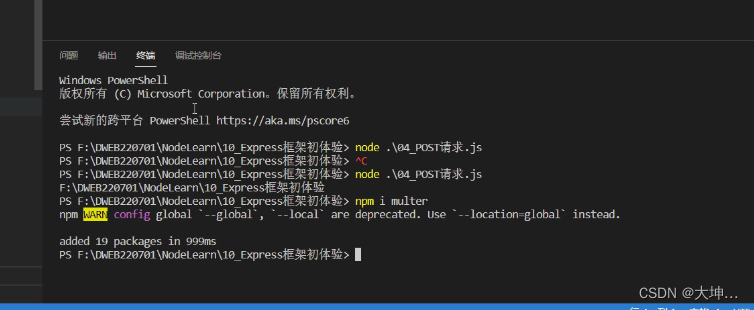GET 用于:地址栏请求 通过url请求
POST 用于:表单请求
DELETE 用于删除
PUT 用于更新
获取GET请求:
GET的请求直接嵌入在路径中URL是完整的请求路径,包括了 ?后面的部分,因此你可以手动解析后面的内容作为GET请求的参数
node.js是UEL模块中的parse函数提供了这个功能。
util是node.js常用工具模块。util.inspect() 是一个将任意对象转化为字符串的方法。通常用于调试和错误输出
var http = require("http")
var url = require("url")
var util = require("util")
// http.createServer 创建一个服务器 require请求 response相应
http.createServer(function (require, response) {
// writeHead 输出相应头 //应头决定了对应的返回数据的格式以及编码格式
response.writeHead(200, { "Content-Type": "text/plain" }); //输出相应头
// util.inspect() 是node.js的常用工具模块,可以将任意对象转化成字符串的方法,通常用于调试和错误输出
// url.parse()方法接受一个URL字符串,解析它,然后返回一个URL对象
// response.end
response.end(util.inspect(url.parse(require.url, true))); //请求
}).listen(8888) //监听端口
console.log("访问:http://127.0.0.1:8888");获取POST请求:
const http = require('http') //HTTP 核心模块是 Node.js 网络的关键模块。
const querystring = require('querystring') //查询字符串
var postHTML =
'<!DOCTYPE html><html><head><meta charset="UTF-8"><title>Document</title></head>' +
'<body>' +
'<form action="" method="post">' +
'姓名:<input type="text" name="name">' +
'<br/>' +
'班级:<input type="text" name="class">' +
'<br/>' +
'<input type="submit">' +
'</form>' +
'</body></html>';
// 创建服务器 请求 响应
http.createServer(function (require, response) {
var body = ''
// 通过require的data事件 监听函数,每当接收到请求体的数据就累加到body变量中
require.on('data', function (turck) {
// +=是默认将二进制转化成字符串格式
body += turck
})
// 通过querystring解析请求体参数,将post请求 变成真正的post请求格式然后向客户端返回
require.on("end", function () {
// 解析参数
body = querystring.parse(body);
// 设置相应 头部即编码
response.writeHead(200, { "Content-Type": "text/html;charset=utf-8" });
if (body.name && body.class) {
// 接受到post数据,输出提交的数据
response.write(`姓名:${body.name}`)
response.write("<br/>")
response.write(`班级:${body.class}`)
} else {
// 未接收到post数据输出表单
response.write(postHTML)
}
response.end();
})
}).listen(8888) //监听端口
console.log("成功:http://127.0.0.1:8888");通过req的data事件监听函数,每当接收到请求体的数据,就累加到body变量中
在end事件触发后,通过querystring.parse 将post解析为正真的POST请求格式,然后向客户端返回
Web模块
什么是Web服务器?
Web一般指网站服务器,是指驻留与因特网上某种类型计算机的程序。
Web服务器的基本功能就是提供Web信息浏览服务,他只需支持HTTP协议。HTML格式及URL与客户端的网络浏览器配合
Web应用架构
Client 客户端 一般指浏览器浏览器可以通过HTTP协议向服务器请求数据。
Server 服务器 一般值Web服务器,可以接收客户端请求,并向客户端发送响应数据。
Business 业务层 通过Web服务器处理应用程序,如与数据库交互,逻辑运算,调用外部程序等
Data 数据层 一般有数据库组成。
使用Node创建Web服务器
解析url 找到 pathname
substr(1) 截取字符串
1.创建服务器
2.获取url 解析url url.parse 找到 pathname
3.判断是否有!pathname || pathname==’/‘
4.读取文件 fs.异步调用
5.创建html文件
// 引入模块
var http = require('http')
var url = require("url")
var fs = require("fs")
// 创建函数
http.createServer(function (request, response) {
// 获取到url通过 parse解析 url 并找到 pathname
let pathname = url.parse(request.url).pathname
if (!pathname || pathname == '/') {
pathname = "/index.html"
}
fs.readFile(pathname.substr(1), function (err, data) {
if (err) {
response.writeHead(404, { "Content-Type": "text/html" })
} else {
response.writeHead(200, { "Content-Type": "text/html" })
response.write(data.toString())
}
response.end()
})
}).listen(8888)
console.log("请求成功:http://127.0.0.1:8888");
使用Node模拟客户端
host 主机名 port 端口号 path路径 data监视数据变化 end完成接收的
注意 :服务器要开启
// 注意 :服务器要开启
const http = require("http")
// 用于请求的选型
var options = {
host: 'localhost', //主机名
port: '8888', //端口号
path: '/index.html' //地址 路径
}
// 处理响应的回调函数
function callback(res) {
var body = ''
// 获取index里面的内容 把他复制给 data监视数据变化
res.on('data', function (trunk) {
body += trunk
})
//end完成接收的
res.on("end", function () {
console.log(body);
})
}
// 请求
var req = http.request(options, callback)
req.end() //调用end
Express框架
安装 npm i express
第一个Express框架实例
路由
路由规则
// 引入块
const express = require('express')
// 函数
const app = express()
// get请求 请求 相应 request请求 response相应 返回到页面的是用 response
arr.get('/', function (request, response) {
response.send("Hello get") //send() 假如发送字符串,那么将被解释为html文件;
})
arr.post('/post.html', function (request, response) {
response.send("Hello post")
})
arr.delete('/delete.html', function (request, response) {
response.send("Hello delete")
})
arr.put('/put.html', function (request, response) {
response.send("Hello put")
})
arr.listen(8888)
console.log("http://127.0.0.1:8888");静态文件
const express = require('express')
const app = express()
//静态
//app.use([地址],中间件|路由|函数体)
app.use(express.static("public"))
app.get('/', function (req, res) {
console.log("get");
res.send("Hello world")
}).listen(8888) //监听端口
console.log("http://127.0.0.1:8888");首先 接收请求 定义了por
接收到 对象 => 字符串(序列化)
字符串=> (反序列化)
const express = require("express")
const app = express()
app.get('/home', function (req, res) {
// 请求
// __dirname 总是指向被执行js文件的绝对路径
res.sendFile(__dirname + "/gethomeGet.html")
})
// 接收porcsee_get
app.get('/porcsee_get', function (req, res) {
// res.send("Hello world")
// 请求 姓 和 名
let obj = {
firat_name: req.query.firat_name,
last_name: req.query.last_name
}
// 接收姓名进行格式转化 'Content-Type': 'text/plain;charset=utf-8'
res.writeHead(200, { 'Content-Type': 'Text/plain;charset=utf-8' })
res.end(`姓名:${obj.firat_name}${obj.last_name}`)
//end()执行完毕后就要输出的字符,如果指定了data的值,那就以为这在执行玩res.end()之后灰阶这执行一条res.write(data,encoding)
})
app.listen(8888) //监听端口
console.log("http://127.0.0.1:8888");POST()
通过浏览器来看到看到这个html 修改路由
路由和提交的路径匹配
body-parser是非常常用的一个express中间件,作用是对post请求的请求体进行解析
const express = require('express')
const app = express()
//body-parser是非常常用的一个express中间件,作用是对post请求的请求体进行解析
const bodyparser = require('body-parser')
const parser = bodyparser.urlencoded({ extended: false })
app.get('/demo', function (req, res) {
// sendfile 函数在两个文件描写叙述符之间直接传递数据(全然在内核中操作,传送),从而避免了内核缓冲区数据和用户缓冲区数据之间的拷贝,操作效率非常高,被称之为零拷贝。
// __dirname用于指向被执行的js文件的绝对路径
res.sendFile(__dirname + "/gethomePost.html")
})
app.post('/porcsee_post', parser, function (req, res) {
let obj = {
firstName: req.body.firat_name,
lastName: req.body.last_name
}
// writeHead 输出相应头 //应头决定了对应的返回数据的格式以及编码格式
res.writeHead(200, { "Content-Type": "text/plain;charset=utf-8" })
res.end(JSON.stringify(`${obj.firstName}${obj.lastName}`))
}).listen(8888)
console.log("http://127.0.0.1:8888");要实现上传
检查又没有 安装multer

引入:const multer = requitre('multer')
上传文件
// 引入模块 express multer
const express = require('express')
const app = express() //
const multer = require('multer')
const fs = require('fs') //读取本地文件
//静态
//app.use([地址],中间件|路由|)
app.use(express.static('public'))
// multer它重要用于上传文件。
const upload = multer({ dest: 'public/uploads/' })
// 接收uploads.html文件
app.get('/uploads', function (req, res) {
// 请求
// sendfile 函数在两个文件描写叙述符之间直接传递数据(全然在内核中操作,传送),从而避免了内核缓冲区数据和用户缓冲区数据之间的拷贝,操作效率非常高,被称之为零拷贝。
// __dirname用于指向被执行的js文件的绝对路径
res.sendFile(__dirname + "/upload.html")
})
app.post('/file_upload', upload.single("image"), function (req, res) {
// res.send("ok")
// console.log(req.file);
let oldName = req.file.destination + req.file.filename;
let newName = req.file.destination + req.file.originalname;
fs.rename(oldName, newName, function (err) {
if (err) {
res.send("上传失败");
} else {
res.send("上传成功");
}
})
})
app.listen(8888)
console.log("http://127.0.0.1:8888");





















 3834
3834











 被折叠的 条评论
为什么被折叠?
被折叠的 条评论
为什么被折叠?








